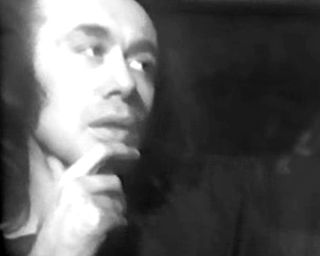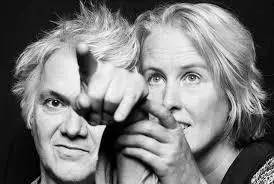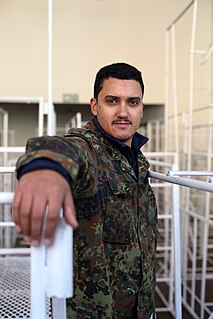
Video art is an art form which relies on using video technology as a visual and audio medium. Video art emerged during the late 1960s as new consumer video technology such as video tape recorders became available outside corporate broadcasting. Video art can take many forms: recordings that are broadcast; installations viewed in galleries or museums; works streamed online, distributed as video tapes, or DVDs; and performances which may incorporate one or more television sets, video monitors, and projections, displaying live or recorded images and sounds.

Nam June Paik was a Korean American artist. He worked with a variety of media and is considered to be the founder of video art. He is credited with the first use (1974) of the term "electronic super highway" to describe the future of telecommunications.

Vito Acconci was an influential American performance, video and installation artist, whose diverse practice eventually included sculpture, architectural design, and landscape design. His foundational performance and video art was characterized by "existential unease," exhibitionism, discomfort, transgression and provocation, as well as wit and audacity, and often involved crossing boundaries such as public–private, consensual–nonconsensual, and real world–art world. His work is considered to have influenced artists including Laurie Anderson, Karen Finley, Bruce Nauman, and Tracey Emin, among others. Acconci was initially interested in radical poetry, but by the late 1960s, he began creating Situationist-influenced performances in the street or for small audiences that explored the body and public space. Two of his most famous pieces were Following Piece (1969), in which he selected random passersby on New York City streets and followed them for as long as he was able, and Seedbed (1972), in which he claimed that he masturbated while under a temporary floor at the Sonnabend Gallery, as visitors walked above and heard him speaking.

Jodi, is a collective of two internet artists, Joan Heemskerk and Dirk Paesmans, created in 1994. They were some of the first artists to create Web art and later started to create software art and artistic computer game modification. Their most well-known art piece is their website, which is a landscape of intricate designs made in basic HTML. JODI is represented by Upstream Gallery, Amsterdam.

Catherine Sue Opie is an American fine-art photographer and educator. She lives and works in West Adams, Los Angeles, as a professor of photography at University of California at Los Angeles.

Mona Hatoum is a British-Palestinian multimedia and installation artist who lives in London.

Carolee Schneemann was an American visual experimental artist, known for her multi-media works on the body, narrative, sexuality and gender. She received a B.A. in poetry and philosophy from Bard College and a Master of Fine Arts from the University of Illinois. Originally a painter in the Abstract Expressionist tradition, Schneeman was uninterested in the masculine heroism of New York painters of the time and turned to performance-based work, primarily characterized by research into visual traditions, taboos, and the body of the individual in relation to social bodies. Although renowned for her work in performance and other media, Schneemann began her career as a painter, stating, "I'm a painter. I'm still a painter and I will die a painter. Everything that I have developed has to do with extending visual principles off the canvas." Her works have been shown at the Los Angeles Museum of Contemporary Art, the Museum of Modern Art in New York, the London National Film Theatre, and many other venues.

Daniel Graham was an American visual artist, writer, and curator in the writer-artist tradition. In addition to his visual works, he published a large array of critical and speculative writing that spanned the spectrum from heady art theory essays, reviews of rock music, Dwight D. Eisenhower's paintings, and Dean Martin's television show. His early magazine-based art predates, but is often associated with, conceptual art. His later work focused on cultural phenomena by incorporating photography, video, performance art, glass and mirror installation art structures, and closed-circuit television. He lived and worked in New York City.
Teresita Fernández is a New York-based visual artist best known for her public sculptures and unconventional use of materials. Her work is characterized by an interest in perception and the psychology of looking. Her experiential, large-scale works are often inspired by landscape and natural phenomena as well as diverse historical and cultural references. Her sculptures present spectacular optical illusions and evoke natural phenomena, land formations, and water in its infinite forms.

Endurance art is a kind of performance art involving some form of hardship, such as pain, solitude or exhaustion. Performances that focus on the passage of long periods of time are also known as durational art or durational performances.
Kate Rich is an Australian-born artist and trader, currently living in Bristol, United Kingdom. Her practice includes sound art, video art, social practice, hospitality, and sport art.

Robin Rhode is a South African artist based in Berlin. He has made wall drawings, photographs and sculptures.

Barbara Ann Rosenthal is an American avant-garde artist, writer and performer. Her existential themes have contributed to contemporary art and philosophy. Her pseudonyms include "Homo Futurus," taken from the title of one of her books and "Cassandra-on-the-Hudson," which alludes to "the dangerous world she envisions" while creating art in her studio and residence, located since 1998 on the Hudson River in Greenwich Village, NYC.
Sanford Biggers is a Harlem-based interdisciplinary artist who works in film/video, installation, sculpture, music, and performance. An L.A. native, he has lived and worked in New York City since 1999.
Dawn Kasper is a New York-based interdisciplinary artist working across genres of performance, installation, sculpture, drawing, photography, video, and sound. Her often improvisational work derives from a "fascination with existentialism, subjects of vulnerability, desire, and the construction of meaning." Kasper uses props, costume, comedy, gesture, repetition, music, and monologue to create what she refers to as "living sculptures."
Harmony Hammond is an American artist, activist, curator, and writer. She was a prominent figure in the founding of the feminist art movement in 1970's New York.

Senga Nengudi is an African-American visual artist and curator. She is best known for her abstract sculptures that combine found objects and choreographed performance. She is part of a group of African-American avant-garde artists working in New York City and Los Angeles, from the 1960s and onward.
Karen Heagle is an American artist, known for autobiographical and art historical subject matter. Her work comments on contemporary culture through a queer perspective with a focus on feminist agendas.
Diane Borsato is a Canadian visual artist whose work explores pedagogical practices and experiential ways of knowing through performance, intervention, video, installation, and photography. Her multidisciplinary and socially engaged works are often created through the mobilization of distinct groups of people including arts professionals, artists, and naturalists. Her work has been widely exhibited in galleries, museums and artist-run-centres across Canada and internationally, including the Vancouver Art Gallery, Power Plant Contemporary Art Gallery, The Art Gallery of York University, the National Museum of Fine Arts of Quebec, Art Metropole, Mercer Union, the Musée d'Art Contemporain in Montreal, and in galleries in the US, France, Germany, Mexico, Taiwan and Japan. Borsato was a Sobey Art Award nominee in 2011 and 2013 and the recipient of the Victor Martyn Lynch-Staunton Award in 2008 for her research and practices in the Inter-Arts category from the Canada Council for the Arts. In 2013, she was an artist in residence at The Art Gallery of Ontario where she created actions, like Tea Service(Conservators Will Wash the Dishes) and Your Temper, My Weather, that animated the collections and environments of the gallery. Borsato is an Associate Professor of Interdisciplinary Studio at the University of Guelph where she teaches in the areas of 2D Integrated Media, Extended Practices and in the MFA program. She creates advanced, thematic studio courses that explore social and conceptual practices that have included Food and Art, Special Topics on Walking, LIVE ART and Outdoor School.

Melati Suryodarmo is an Indonesian durational performance artist. Her physically demanding performances make use of repetitive motions and often last for many hours, sometimes reaching "a level of factual absurdity". Suryodarmo has performed and exhibited throughout Europe and Asia as well as in North America. Born in Surakarta, she attended Padjadjaran University, graduating with a degree in international relations before moving to Germany. She lived there for 20 years, studying performance art at the Braunschweig University of Art with Butoh choreographer Anzu Furukawa and performance artist Marina Abramović.













